闪存PIN介绍
BitLocker 驱动器加密

了解有关BitLocker驱动器加密的更多信息BitLocker驱动器加密可为丢失或被盗的操作系统驱动器、固定数据驱动器和可移动数据驱动器提供保护。
BitLocker是通过以下方法来提供保护的:加密驱动器的内容并要求用户对其凭据进行身份验证来访问该信息。
在安装Windows 的驱动器上,BitLocker使用受信任的平台模块(TPM) 来检测计算机的关键启动进程是否已被篡改。
另外,可能要求用户提供PIN 或启动密钥才能访问驱动器数据。
在固定数据驱动器和可移动数据驱动器上,用户可以通过使用密码、通过使用智能卡或通过自动解锁驱动器来访问受BitLocker保护的驱动器。
操作系统驱动器的BitLocker专门用于处理具有兼容TPM 安全硬件和BIOS 的系统。
若要与BitLocker兼容,计算机制造商必须遵守受信任计算组(TCG) 定义的标准。
有关TCG 的详细信息,请访问受信任计算组网站(/fwlink/?LinkId=67440)。
启用BitLockerBitLocker安装向导可以从控制面板或Windows 资源管理器启动,它用于在计算机上安装的固定数据驱动器或可移动数据驱动器上启用BitLocker,或者用于在具有兼容TPM 的计算机的操作系统驱动器上启用BitLocker。
如果希望在不带TPM 的计算机的操作系统驱动器上启用BitLocker,或者使用其他BitLocker功能和选项,则可以修改BitLocker组策略设置,这些设置控制通过BitLocker安装向导可以访问哪些功能。
在带有兼容TPM 的计算机上,可以使用以下四种方式解锁受BitLocker保护的操作系统驱动器:仅TPM。
使用“仅TPM”验证不要求与用户进行任何交互来解密驱动器及提供对驱动器的访问。
如果TPM 验证成功,则用户登录体验与标准登录相同。
如果缺少或已更改TPM,或者如果TPM 检测到关键的操作系统启动文件发生更改,则BitLocker将进入其恢复模式,需要恢复密码才能重新获得对数据的访问权限。
闪存卡简介
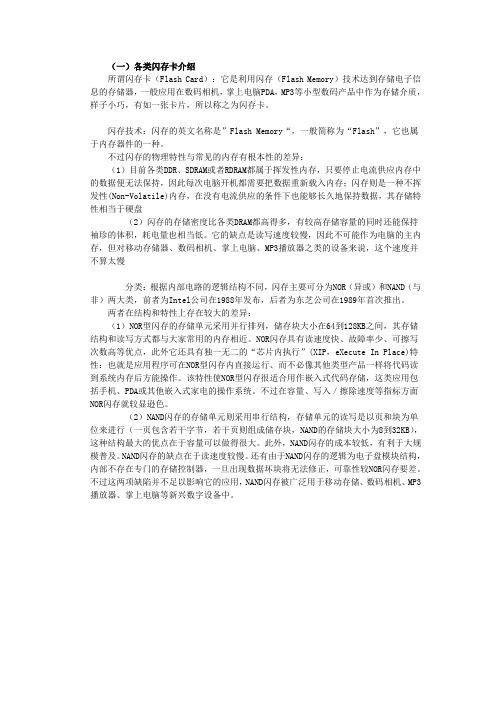
(一)各类闪存卡介绍所谓闪存卡(Flash Card):它是利用闪存(Flash Memory)技术达到存储电子信息的存储器,一般应用在数码相机,掌上电脑PDA,MP3等小型数码产品中作为存储介质,样子小巧,有如一张卡片,所以称之为闪存卡。
闪存技术:闪存的英文名称是”Flash Memory“,一般简称为“Flash”,它也属于内存器件的一种。
不过闪存的物理特性与常见的内存有根本性的差异:(1)目前各类DDR、SDRAM或者RDRAM都属于挥发性内存,只要停止电流供应内存中的数据便无法保持,因此每次电脑开机都需要把数据重新载入内存;闪存则是一种不挥发性(Non-Volatile)内存,在没有电流供应的条件下也能够长久地保持数据,其存储特性相当于硬盘(2)闪存的存储密度比各类DRAM都高得多,有较高存储容量的同时还能保持袖珍的体积,耗电量也相当低。
它的缺点是读写速度较慢,因此不可能作为电脑的主内存,但对移动存储器、数码相机、掌上电脑、MP3播放器之类的设备来说,这个速度并不算太慢分类:根据内部电路的逻辑结构不同,闪存主要可分为NOR(异或)和NAND(与非)两大类,前者为Intel公司在1988年发布,后者为东芝公司在1989年首次推出。
两者在结构和特性上存在较大的差异:(1)NOR型闪存的存储单元采用并行排列,储存块大小在64到128KB之间,其存储结构和读写方式都与大家常用的内存相近。
NOR闪存具有读速度快、故障率少、可擦写次数高等优点,此外它还具有独一无二的“芯片内执行”(XIP,eXecute In Place)特性:也就是应用程序可在NOR型闪存内直接运行、而不必像其他类型产品一样将代码读到系统内存后方能操作。
该特性使NOR型闪存很适合用作嵌入式代码存储,这类应用包括手机、PDA或其他嵌入式家电的操作系统。
不过在容量、写入/擦除速度等指标方面NOR闪存就较显逊色。
(2)NAND闪存的存储单元则采用串行结构,存储单元的读写是以页和块为单位来进行(一页包含若干字节,若干页则组成储存块,NAND的存储块大小为8到32KB),这种结构最大的优点在于容量可以做得很大。
认识SSD固态硬盘主控芯片和闪存芯片详解

认识SSD固态硬盘,主控芯片和闪存芯片详解SSD是何物SSD是英文Solid State Disk缩写,中文名为固态硬盘,就是有闪存芯片替代传统碟片制造出来的硬盘。
尽管固态硬盘在接口规范、产品尺寸上与机械硬盘相同。
但正是因为固态硬盘没有传统硬盘中哪些电机、磁头等机械部件,所以其抗震性能很好,完全没有噪音,还降低了功耗与发热量。
主控芯片和闪存芯片是SSD中最为重要的两个原件,也是影响SSD性能的主要因素。
其中主控芯片是SSD的大脑,而闪存芯片则是SSD的数据仓库。
所以要走进SSD的内部世界,我们就要详细了解主控芯片和闪存芯片的作用。
固态硬盘拆解图固态硬盘中的“CPU”在SSD中,主控看上去只是一颗躲在某个角落、并不起眼的小芯片。
有句老话叫“秤砣小,压千斤”,这用来形容主控芯片一点也不为过,除了存储部分由闪存芯片负责之外,固态硬盘的功能、规格、工作方式等正是由这颗小小的芯片控制的。
主控芯片在SSD中的作用就跟CPU一样,主要是面向调度、协调和控制整个SSD系统而设计的。
主控芯片一方面负责合理调配数据在各个闪存芯片上的负荷,另一方面承担了整个数据中转,连接闪存芯片和外部SATA接口。
除此之外,主控还负责ECC纠错、耗损平衡、坏块映射、读写缓存、垃圾回收以及加密等一系列的功能。
典型SSD架构,主控占据了相当重要的位置由于SSD主控的技术含量不低,能玩得转的其实没几家,主要有Marvell、英特尔、三星、OCZ、SandForce、Jmicro等几个厂商。
主控性能的好换主要取决于这些主控厂商的技术实力,以及拥有什么样的绝技。
例如不同厂商推出的主控芯片在数据处理能力、算法、对闪存芯片的读取写入控制上会有非常大的不同,直接会导致固态硬盘产品在性能上差距高达数十倍。
所以在挑选SSD,首先得挑选主控,这是SSD性能的基础。
另外再多说一句,主控性能的发挥也和firmware固件有关,后者相当于SSD的“操作系统”,而固件更新能给性能带来大幅的提升。
Pixhawk简介
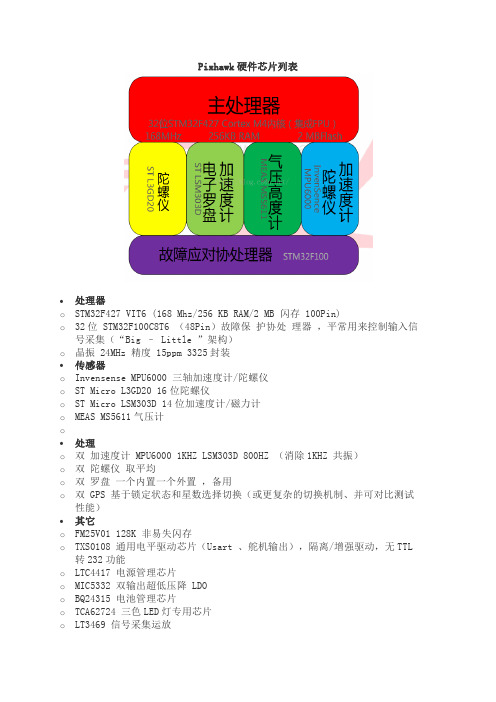
Pixhawk硬件芯片列表•处理器o STM32F427 VIT6 (168 Mhz/256 KB RAM/2 MB 闪存 100Pin)o32位 STM32F100C8T6 (48Pin)故障保护协处理器,平常用来控制输入信号采集(“Big –Little ”架构)o晶振 24MHz 精度 15ppm 3325封装•传感器o Invensense MPU6000 三轴加速度计/陀螺仪o ST Micro L3GD20 16位陀螺仪o ST Micro LSM303D 14位加速度计/磁力计o MEAS MS5611气压计o•处理o双加速度计 MPU6000 1KHZ LSM303D 800HZ (消除1KHZ 共振)o双陀螺仪取平均o双罗盘一个内置一个外置,备用o双 GPS 基于锁定状态和星数选择切换(或更复杂的切换机制、并可对比测试性能)•其它o FM25V01 128K 非易失闪存o TXS0108 通用电平驱动芯片(Usart 、舵机输出),隔离/增强驱动,无TTL 转232功能o LTC4417 电源管理芯片o MIC5332 双输出超低压降 LDOo BQ24315 电池管理芯片o TCA62724 三色LED灯专用芯片o LT3469 信号采集运放o可外接 MS4522D 数字差压空速计(6.6V ADC 输入)3.Pixhawk传感器列表空速计---IIC接口电源管理SMbus---IIC航灯接口---IICBMA180角速度传感器----SPI地磁HMC5883---IIC/SPIL3GD20陀螺仪----SPILSM303D角速度/地磁-----SPI超声波MB12xx----IICMD25---IICMPU6000----SPIMS5611气压计----SPI板载灯控制器TCA62724FMG-----IICPC8574(IIC转并) ----IICPCA9685(IIC/PWM)-----IIC光流模块----IIC4.pixhawk硬件构架5.pixhawk硬件连接关系(1)对照原理图查看所有传感器及接口方式,在F4上的接口;(2)研究下F4和F1的沟通连接方式,以及F1的主要任务;(3)基于以上两点,结合框架文档丰富对硬件架构的认识;规定以下没有括号()的表示网络标号,有括号()的表示具体引脚stm32f427Invensense MPU6000三轴加速度计/陀螺仪PC2(stm32f427)---MPU_CS---CS(MPU6000)PA6(stm32f427)---SPI_INT_MISO---AD0/SDO(MPU6000)PD15(stm32f427)---MPU_DRDY---INT(MPU6000)PA7(stm32f427)---SPI_INT_MOSI---SDA/SDI(MPU6000)PA5(stm32f427)---SPI_INT_SCK---SCL/SCLK(MPU6000)电源VDD_3V3_SENSORSST Micro L3GD20 16位陀螺仪PC13(stm32f427)---GYRO_CS---CS(L3GD20)PA6(stm32f427)---SPI_INT_MISO---SDO/SA0(L3GD20)PB0(stm32f427)---GYRO_DRDY---INT(L3GD20)PA7(stm32f427)---SPI_INT_MOSI---SDA/SDI/SDO(L3GD20) PA5(stm32f427)---SPI_INT_SCK---SCL/SPC(L3GD20)电源VDD_3V3_SENSORSST Micro LSM303D 14位加速度计/磁力计PC15(stm32f427)---ACCEL_MAG_CS---CS(LSM303D)PA6(stm32f427)---SPI_INT_MISO---SDO/SA0(LSM303D)PB4(stm32f427)---ACCEL_DRDY---INT1(LSM303D)PA7(stm32f427)---SPI_INT_MOSI---SDA/SDI/SDO(LSM303D) PA5(stm32f427)---SPI_INT_SCK---SCL/SPC(LSM303D)PB1(stm32f427)---MAG_DRDY---INT2(LSM303D)电源VDD_3V3_SENSORSMEAS MS5611气压计PD7(stm32f427)---BARO_CS---CS(MS5611)PA6(stm32f427)---SPI_INT_MISO---SDO (MS5611)PA7(stm32f427)---SPI_INT_MOSI---SDI/SDA (MS5611)PA5(stm32f427)---SPI_INT_SCK---SCLK(MS5611)电源VDD_3V3_SENSORS存储器PB13(stm32f427)---FRAM_SCK---C(FM25V01)PB14(stm32f427)---FRAM_MISO---Q(FM25V01)PB13(stm32f427)---FRAM_MOSI---D(FM25V01)PD10(stm32f427)---FRAM_CS---S(FM25V01)电源FMU-VDD_3V3高亮LEDPB8(stm32f427)---FMU-I2C1_SCLPB9(stm32f427)---FMU-I2C1_SDAPB10(stm32f427)---FMU-I2C2_SCLPB11(stm32f427)---FMU-I2C1_SDAUSBPA9(stm32f427)---VBUS 电源PA11(stm32f427)---OTG_FS_DMPA12(stm32f427)---OTG_FS_DPPC0(stm32f427)--- VBUS_VALID USB电源有效标志TF卡PC8(stm32f427)---SDIO_D0PC9(stm32f427)---SDIO_D1PC10(stm32f427)---SDIO_D2PC11(stm32f427)---SDIO_D3PC12(stm32f427)---SDIO_CKTEL2_OSDPD8(stm32f427)---FMU-USART3_TXPD9(stm32f427)---FMU-USART3_RXPD11(stm32f427)---FMU-USART3_CTSPD12(stm32f427)---FMU-USART3_RTSTEL1_数传PD3(stm32f427)---FMU-USART3_ CTSPD4(stm32f427)---FMU-USART3_ RTSPD5(stm32f427)---FMU-USART3_TXPD6(stm32f427)---FMU-USART3_RX面板GPSPA0(stm32f427)---FMU-UART4_TXPA1(stm32f427)---FMU-UART4_RX面板CANPD0 (stm32f427)---CAN1_RXPD1 (stm32f427)---CAN1_TX6路辅助PWMPE14(stm32f427)---FMU-CH1PE13(stm32f427)---FMU-CH2PE11(stm32f427)---FMU-CH3PE9 (stm32f427)---FMU-CH4PD13(stm32f427)---FMU-CH5PD14(stm32f427)---FMU-CH6LEDPE12(stm32f427)---FMU-LED_AMBERstm32f427与stm32f100连接PC6(stm32f427)---SERIAL_FMU_TO_IO---PA3(stm32f100) PC7(stm32f427)---SERIAL_IO_TO_FMU---PA2(stm32f100) stm32f1008路主PWMPA0(stm32f100)---IO-CH1PA1(stm32f100)---IO-CH2PB8(stm32f100)---IO-CH3PB9(stm32f100)---IO-CH4PA6(stm32f100)---IO-CH5PA7(stm32f100)---IO-CH6PB0(stm32f100)---IO-CH7PB1(stm32f100)---IO-CH8安全开关PB5(stm32f100)---SAFTYLEDPB13(stm32f100)---IO-LED_SAFTY PB14(stm32f100)---IO-LED_BLUE PB15(stm32f100)---IO-LED_AMBER PPM接收PA8(stm32f100)---PPM_INPUTS.BUSPB4(stm32f100)---SBUS_OUTPUT_EN PB10(stm32f100)---SBUS_OUTPUT PB11(stm32f100)---SBUS_INPUT JTAG电源IO-VDD_3V3PA13(stm32f100)---IO-SWDIOPA14(stm32f100)---IO-SWCLKPB3(stm32f100)---IO-SWO卫星接收机PA10(stm32f100)---IO-USART1_RX PB15(stm32f100)---IO-LED_AMBERPA10(stm32f100)--- VDD_3V3_SPEKTRUM 电源。
FLASH和主控关系

描述:图1,TSOP48封装的FLASH 图片:描述:图2,8位和16位FLASH对比图片:描述:图3,FLASH引脚说明图片:一,基础知识现在数码设备上常用的FLASH基本都是TSOP48封装,其引脚比较密,焊接的时候最好用尖头的烙铁。
见图1,闪存芯片,不同容量是Pin to Pin 的,即芯片的封装、引脚的功能、外围电路都是基本相同的。
可以说是硬件间的兼容,这为FLASH代换提供了基础。
常用的FLASH都属于并行FLASH,是同时可以传输多位数据,分为8位和16位,8位就是说FLASH 有8个数据脚(I/O0-I/O7)也有的是标为(D0-D7),一次可以同时传输8位数据。
16位以此类推。
常用设备中用8位的较多,占到9成以上。
在图2中可以看到,除了数据脚,8位和16位的FLASH其他引脚是一致的。
在图2中我们发现,FLASH的48个引脚中很多都是空的(NC),特别是8位的FLASH(因为16位FLASH用得很少,所以下面的说明都是以位的FLASH作为例子),一共才用了19个脚,这其中我们需要了解的只有2个,CE和R/B脚。
这2个脚对FLASH代换升级有较大影响。
CE是片选,和主控的CE脚相连,只有CE被主控相连选中,FLASH才能工作。
R/B:就绪/忙输出,R/B的输出能够显示设备的操作状态。
R/B处于低电平时,表示有编程、擦除或随机读操作正在进行。
操作完成后,R/B会自动返回高电平。
由于该端是漏极开路输出,所以即使当芯片没有被选中或输出被禁止时,它也不会处于高阻态。
描述:图4,4CE的FLASH 图片:描述:图5,2CE的FLASH 图片:描述:图6,1CE的FLASH图片:前面提到,闪存芯片,不同容量是Pin to Pin 的,即芯片的封装、引脚的功能、外围电路都是基本相同的。
为什么说是基本相同呢?因为不同容量FLASH可能采用的管芯数量不同,从而造成引脚的细微差别。
什么是管芯呢?这要从闪存起源说起。
3-bit-per-cell NAND闪存
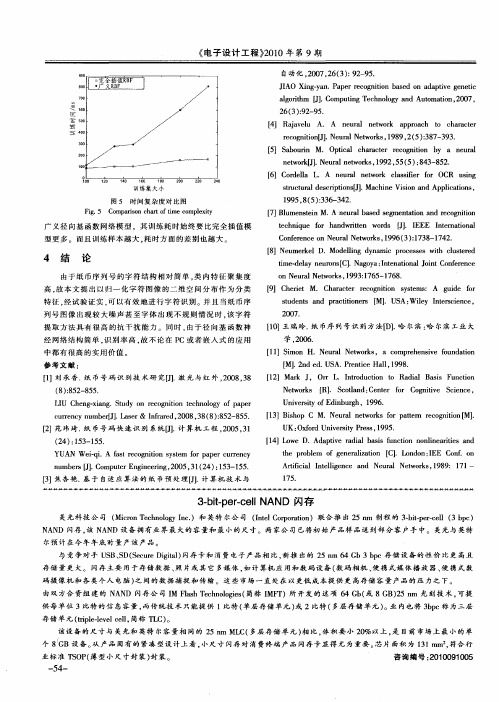
特 征 , 试 验证 实 , 以 有 效 地进 行字 符 识 别 。 且 当纸 币 序 经 可 并 列 号 图像 出 现较 大 噪 声 甚 至 字 体 出 现 不 规 则 情 况 时 , 字 符 该 提 取 方 法 具 有 很 高 的 抗 干 扰 能 力 。同 时 , 于径 向 基 函 数 神 由
N N 闪存 , N N 设 备拥 有 业界 最 大的 容 量 和 最 小 的 尺 寸 。两 家公 司 已将 初 始 产 品 样 品 送 到 部 分 客 户 手 中 。美 光 与 英特 A D 该 A D
尔预 计 在 今 年 年 底 时量 产该 产品 。
与 竞 争 对 手 U B、D Scr ii1闪存 卡和 消 费 电子 产 品 相 比 , 推 出的 2 m 6 b3b c存 储 设 备 的 性 价 比更 高且 S S (eueDgt ) a 新 5n 4G p 存 储 量 更 大 。 闪存 主要 用 于存 储 数 据 、 片或 其 它 多媒 体 , 计 算 机 应 用 和数 码 设 备 ( 码 相 机 、 携 式媒 体播 放 器 、 携 式 数 照 如 数 便 便
(4 :5 — 5 . 2 ) 1 3 1 5
YUAN e— i W iq .A a tr c g to y tm o a rc r nc fs e o niin s se fr p pe ure y
【3 i o 1】Bs p C M.N ua n tok rpt r eont nM】 h e r e rsf a e rcg io 【 . l w o tn i
经 网络 结 构 简 单 , 别 率 高 , 不 论 在 P 识 故 C或 者 嵌 入 式 的 应 用
【0 王 瑞 玲 . 币序 列 号 识 别 方 法【1哈 尔滨 : 尔滨 工 业 大 11 纸 D. 哈
Apricorn 硬盘加密 USB 闪存驱动器说明说明书

ON-THE-FLY 256-BIT AES-XTS HARDWARE ENCRYPTION SOFTWARE-FREE INSTALLATION & OPERATION; COMPLETELY CROSS-PLATFORM COMPATIBLE HIGH-QUALITY RUGGED ALUMINUM HOUSING Water and Dust Resistant EMBEDDED 7-16 DIGIT PIN AUTHENTICATION No Security Parameters Shared with HostsADMIN MODE FOR SECURE DEPLOYMENTINDEPENDENT USER AND ADMIN PINSFORCED ENROLLMENT AT FIRST USETOUGH EPOXY INTERNAL FILLING FOR PHYSICAL-ATTACK PROTECTIONBRUTE-FORCE PROTECTIONSELF-DESTRUCT PIN FEATURE COMPATIBLE WITH ANY OS Windows ®, Mac ®, Linux SUPER-FAST USB 3.0 10X Faster than USB 2.0VARIABLE TIMING CIRCUIT LOCK-OVERRIDE MODE DRIVE-RESET FEATURE AUTO-LOCK FEATURE READ-ONLY MODE Visit our web site at or call 1-800-458-5448©2014 Apricorn, Inc. Corporate Offices: 12191 Kirkham Rd., Poway, CA. 92064HARDWARE ENCRYPTED USB FLASH DRIVE Inside This Tiny Key is a World Of Advanced Data Protection.Software-free operation, cross-platform compatibility, USB 3.0 speed, increased capacities of up to 240GB, plus a host of high-level security features that you’d never expect to find in a itary Grade 256-bit AES XTS Hardware Encryption: All data on theAegis Secure Key is encrypted on-the-fly with built-in 256-bit AES XTS.Software-Free Design: The Aegis Secure Key is ready to use right out of the box–no software, no drivers, no updates involved. It can even be utilized where no keyboard is present (e.g., cockpits, medical equipment, A V gear.) Completely cross-platform compatible, the Aegis Secure Key excels just about anywhere–PCs, MACs, Linux, or any OS with a powered USB port and a storage file system. Embedded Keypad: All PIN entries and controls are performed on the keypad of the Aegis Secure Key. Since there is no host involvement in the key’s authentication or operation, the risk of software hacking and key-logging is completely circumvented.Super Tough, Inside and Out: IP-58 certified as tough enough to go anywhere, the Aegis Secure Key’s resilient design makes it perfect for travel. Its rugged, extruded aluminum casing is resistant to dust and water, and the keypad is wear-resistant. Inside, another layer of protection is added with the injection of a tough epoxy compound to prevent physical access to the key’s encryption circuitry. Independent User and Admin PINs: The Aegis Secure Key can be configured independent User and Admin PINs, making it an ideal device for corporate and government deployment. Should the User forget his or her PIN, the drive can still be unlocked with the Admin PIN and a new User PIN can be created.Auto-Lock Feature: Locks automatically whenever it’s unplugged from its powered USB port, and is further programmable to lock after a predetermined period of inactivity.Drive Reset Feature: Effectively clears both the User and Admin PINs, performs a crypto-erase onthe drive, creates a new randomly generated encryption key, and allows the drive to be redeployed. Capable of generating an infinite number of randomly generated encryption keys, The Aegis Secure Key permits the admin to reset the drive as many times as desired.Brute-Force Protection: After a predetermined number (programmable; up to 20) of incorrect PIN entry attempts, the Aegis Secure Key will conclude that it is under Brute Force Attack and will respond by performing a crypto-erase – deleting the encryption key which will render all of the key’s data useless. VTC Technology: Apricorn’s Variable Time Circuit (VTC) technology is designed to thwart Timing Attacks aimed at accessing the drive by studying usage patterns and infiltrating the Secure Key’s electronics. Lock-Override Mode Feature: Designated for specific cases in which the key needs unlocked, e.g., during reboot, passing the key through a virtual machine, or other similar situations that would normally prompt the key to automatically lock. When enabled, Lock-Override Mode allows the key to remain unlocked through USB port re-enumeration and will not re-lock until USB power is interrupted.Read-Only Mode Feature: Perfect for accessing data on the key in a public setting to protect against USB viruses or Trojan attachments. Particularly important in forensics, Read-Only Mode is ideal for applications that require data to be preserved in its original, unaltered state and can’t be overwritten or modified.Self-Destruct Feature: The last line of defense for data security where all of the drive’s contents must be wiped to avert breach. The Secure Key’s Self-Destruct PIN defends against physically compromising situations by erasing the key’s contents, leaving it in normal working order and to appear as if it has yet to be deployed.Aegis Secure Key 3.0WORKS WITH:For more information on Aegis Secure Key and other innovativeApricorn products visit our web site at or call 1-800-458-5448©2014 Apricorn, Inc. Corporate Offices: 12191 Kirkham Rd., Poway, CA. 92064*One gigabyte (GB) = one billion bytes; accessible capacity will be less and actual capacity depends on the operating environment and formatting.STEP 1Enter your PINPlug & Play Press Lock or Unplug to Lock STEP 2STEP 3rev 09-18-15。
固态硬盘闪存大揭秘:白片、黑片、划线片、拆机片

固态硬盘闪存大揭秘:白片、黑片、划线片、拆机片我们在选择SSD的时候,最为关注的除了SSD主控,便是SSD 的闪存了。
SSD的闪存类型和闪存芯片级别是SSD性能的根本。
SSD的闪存类型,市场上主流的无非四种:TLC、3D TLC、MLC、3D MLC(按照闪存性能从低到高排列)。
准确的说是三种,据我所知采用3D MLC NAND的,目前市面上好像只有阿斯加特AN Series M.2 SSD 256G这一款。
据说是因为全球首发,打开销量才这样不惜血本。
SSD闪存类型没什么好说。
我们今天要讲的是,SSD闪存的芯片级别。
闪存的芯片级别分为:正片:正片闪存通过了全部产品测试,然后激光打标了产品信息。
白片:白片是在测试时部分测试未通过的闪存芯片。
这些闪存芯片再经过一些测试后,如果不影响使用,就打标并和正片一样流向市场。
由于全球晶圆紧缺,闪存价格飞涨,正片供不应求。
正片做SSD 成本高昂,而且还没货。
因此市面上主流的SSD基本上都是使用的白片闪存。
白片闪存相对正片在价格上有优势,做成SSD同样有价格优势。
在性能上,好的白片性能与正片相差无几。
白片SSD可以说是物美价廉。
既然市面上白片很普遍。
那怎样去识别白片呢?我们拿镁光的白片来说。
镁光白片,网友称之为大S或者小S。
不是徐熙媛,也不是徐熙娣,是SpecTek。
SpecTek是镁光旗下的一个子公司。
镁光的白片就是交给它来进行各种测试,在测试完毕后上市的。
测试完以后SpecT ek会给白片闪存一个物料编号。
下面是SpecTek的物料编码规则。
对于这个编码规则,大家不用了解太多。
我们稍微讲一些重点问题。
镁光的SpecTek闪存芯片,物料编码前两位只能是FN/FT/FB/FX,如果不是,可能你就遇到黑片了。
由于上面说到,镁光的白片几乎都经过SpecTek才出货的,所以我们通过识别闪存物料号的前两位,也基本上能够识别出镁光的白片和黑片了。
镁光的SpecTek闪存芯片第4位是显示闪存的类型。
U盘FLASH芯片代换升级完全手册

U盘FLASH芯片代换升级完全手册(同样适用于MP3/4/5)FLASH芯片代换升级在MP3维修和U盘DIY中是经常要用到的,比如维修MP4的时候怀疑固件问题,想刷FW,但是手上没有确定正确的固件的时候,常常会焊下原机FLASH,焊上代用的FLASH来刷固件,以避免故障扩大。
而如果是怀疑FLASH损坏,那代换FLASH更是必不可少了。
图1 TSOP48封装的FLASH图3 主要引脚说明一,基础知识现在数码设备上常用的FLASH基本都是TSOP48封装,其引脚比较密,焊接的时候最好用尖头的烙铁。
见图1,闪存芯片,不同容量是Pin to Pin 的,即芯片的封装、引脚的功能、外围电路都是基本相同的。
可以说是硬件间的兼容,这为FLASH代换提供了基础。
常用的FLASH都属于并行FLASH,是同时可以传输多位数据,分为8位和16位,8位就是说FLASH有8个数据脚(I/O0-I/O7)也有的是标为(D0-D7),一次可以同时传输8位数据。
16位以此类推。
常用设备中用8位的较多,占到9成以上。
在图2中可以看到,除了数据脚,8位和16位的FLASH其他引脚是一致的。
在图2中我们发现,FLASH的48个引脚中很多都是空的(NC),特别是8位的FLASH(因为16位FLASH用得很少,所以下面的说明都是以8位的FLASH作为例子),一共才用了19个脚,这其中我们需要了解的只有2个,CE和R/B脚。
这2个脚对FLASH代换升级有较大影响。
CE是片选,和主控的CE脚相连,只有CE被主控相连选中,FLASH才能工作。
R/B:就绪/忙输出,R/B的输出能够显示设备的操作状态。
R/B处于低电平时,表示有编程、擦除或随机读操作正在进行。
操作完成后,R/B会自动返回高电平。
由于该端是漏极开路输出,所以即使当芯片没有被选中或输出被禁止时,它也不会处于高阻态。
图4 4CE的FLASH 图5 2CE的FLASH图6 1CE的FLASH前面提到,闪存芯片,不同容量是Pin to Pin 的,即芯片的封装、引脚的功能、外围电路都是基本相同的。
Nand-Flash详述(绝对经典)
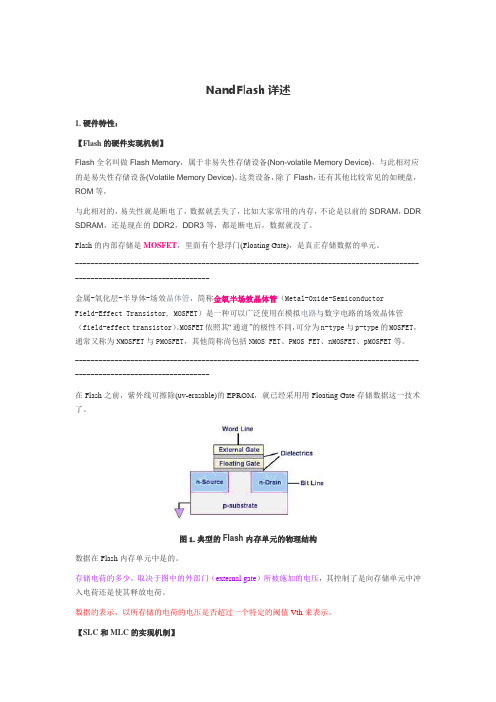
NandFlash详述1. 硬件特性:【Flash的硬件实现机制】Flash全名叫做Flash Memory,属于非易失性存储设备(Non-volatile Memory Device),与此相对应的是易失性存储设备(Volatile Memory Device)。
这类设备,除了Flash,还有其他比较常见的如硬盘,ROM等,与此相对的,易失性就是断电了,数据就丢失了,比如大家常用的内存,不论是以前的SDRAM,DDR SDRAM,还是现在的DDR2,DDR3等,都是断电后,数据就没了。
Flash的内部存储是MOSFET,里面有个悬浮门(Floating Gate),是真正存储数据的单元。
-------------------------------------------------------------------------------------------------------------------------金属-氧化层-半导体-场效晶体管,简称金氧半场效晶体管(Metal-Oxide-SemiconductorField-Effect Transistor, MOSFET)是一种可以广泛使用在模拟电路与数字电路的场效晶体管(field-effect transistor)。
MOSFET依照其“通道”的极性不同,可分为n-type与p-type的MOSFET,通常又称为NMOSFET与PMOSFET,其他简称尚包括NMOS FET、PMOS FET、nMOSFET、pMOSFET等。
-------------------------------------------------------------------------------------------------------------------------在Flash之前,紫外线可擦除(uv-erasable)的EPROM,就已经采用用Floating Gate存储数据这一技术了。
闪存FLASH代换升级

FLASH代换升级手册一、基础知识闪存芯片,不同容量是Pin to Pin 的,即芯片的封装、引脚的功能、外围电路都是基本相同的。
可以说是硬件间的兼容,这为FLASH代换提供了基础。
常用的FLASH都属于并行FLASH,是同时可以传输多位数据,分为8位和16位,8位就是说 FLASH有8个数据脚(I/O0-I/O7)也有的是标为(D0-D7),一次可以同时传输8位数据。
16位以此类推。
常用设备中用8位的较多,占到90%以上。
在图1中可以看到,除了数据脚,8位和16位的FLASH其他引脚是一致的。
在图1中我们发现,FLASH的48个引脚中很多都是空的(NC),特别是8位的FLASH(因为16位FLASH用得很少,所以下面的说明都是以8位的FLASH 作为例子),一共才用了19个脚,这其中我们需要了解的只有2个,CE和R/B脚。
这2个脚对FLASH代换升级有较大影响。
CE是片选,和主控的CE脚相连,只有CE被主控相连选中,FLASH 才能工作。
R/B:就绪/忙输出,R/B的输出能够显示设备的操作状态。
R/B处于低电平时,表示有编程、擦除或随机读操作正在进行。
操作完成后,R/B会自动返回高电平。
由于该端是漏极开路输出,所以即使当芯片没有被选中或输出被禁止时,它也不会处于高阻态。
图1 8位与16位对比图2 FLASH引脚说明前面提到,闪存芯片,不同容量是Pin to Pin 的,即芯片的封装、引脚的功能、外围电路都是基本相同的。
为什么说是基本相同呢?因为不同容量FLASH可能采用的管芯数量不同,从而造成引脚的细微差别。
什么是管芯呢?这要从闪存起源说起。
1984年,东芝发明闪存技术,直接催生出多种产品问世:MP3播放器、PDA,数码相机,智能手机等。
作为行业标准制定者,2000年,东芝倡导成立SD协会,衍生出包括:SD卡、mini sd卡、TF/MicroSD卡等,被各种电子产品广泛应用。
闪存盘应该是在2000年首次面市,当时全球共有5家企业拥有自有闪存盘品牌的销售,这5家主要是以色列的M-system、新加坡Track、朗科优盘、鲁文易盘和韩国FlashDriver。
东芝闪存芯片编号规则再阐述

东芝闪存芯片编号规则再阐述1. 引言东芝是一家全球知名的电子产品制造商,闪存芯片是其主要产品之一。
为了方便产品管理和标识,东芝为其闪存芯片制定了一套编号规则。
本文将重新阐述东芝闪存芯片编号规则,并探讨其背后的原理和应用。
2. 东芝闪存芯片编号规则概述东芝的闪存芯片编号规则基于一套统一的体系,以便对不同系列、型号和容量的芯片进行准确的识别和分类。
该规则通常由一串数字和字母组成,每个字符都代表特定的信息。
我们来看一下东芝闪存芯片编号规则的基本结构。
通常,编号由四个部分组成:前缀、主体、容量和版本号。
- 前缀:这是一个由若干字母组成的代码,用于表示芯片所属的系列或产品线。
不同的系列可能具有不同的功能和特性,通过前缀可以快速区分不同系列的芯片。
TH表示东芝的高速读写系列芯片,SLC表示单级单元系列芯片。
- 主体:主体部分是编号的核心,在这里包含了芯片的型号和序列号。
型号用于区分同一系列中不同容量或特性的芯片,而序列号用于区分同一型号的不同批次或生产线的芯片。
- 容量:容量部分用于表示闪存芯片的存储容量,通常以GB或TB为单位。
不同容量的芯片可能具有不同的价格和应用场景,通过容量信息可以帮助用户选择适当的产品。
- 版本号:版本号用于表示芯片的硬件或固件版本,可以用于追踪产品的升级和改进历史。
对于一些要求高可靠性和稳定性的应用,版本号信息尤为重要。
3. 东芝闪存芯片编号规则的深度解析现在我们将深入探讨东芝闪存芯片编号规则背后的原理和应用。
通过对规则中各个部分的理解,我们可以更好地了解芯片的特性和适用场景。
前缀部分起到了对芯片进行分类和归类的作用。
通过使用不同的前缀,东芝可以将芯片划分为多个系列,以满足不同用户的需求。
高速读写系列(TH)的芯片适用于需要更快速度的应用,而单级单元系列(SLC)的芯片则具有更高的可靠性和耐久性。
主体部分包含了芯片的型号和序列号。
通过型号,用户可以了解到芯片的具体特性和规格。
而序列号则有助于追踪同一型号芯片的差异,例如不同批次或生产线的芯片可能会存在细微的性能差异。
内存条与闪存卡

内存条与闪存卡发表时间:2004-10-30目前工作在数字、通讯、网络、摄录像音等的设备,如PC机、打印机、服务器、小型机、工业机、图形工作站、路由器、主板、显卡、手机、掌中机、商务通、数码相机、DV中均不可缺少的一个关键部件,即内存条(块),而数码设备中则称为闪存卡。
内存决定了这些设备的实际工作速度与存储量。
下面对PC机内存条、数码相机的闪存卡作一些简单介绍。
SDRAMKingSton P133 128MB SD 168 Pin内存条背面标有“168” 表示168线内存条正面下文标有“84”现代内存条颗粒上标有 HY57V56820AT-H 其中“56”表示256MB;而128MB条“HY57V”后面数字为“28”。
现代 256MB SD 168 Pin现代 128MB SD 168 Pin目前大多尚未升级换代的电脑仍使用的是SDRAM内存条,从上图可以看到:1、SDRAM内存条两则有个半园缺口,它是内存条插入内存插槽DIMM上卡子的卡槽,用于固定内存条。
2、SDRAM内存条电路板两面否有颗粒(内存块)分为单面与双面。
一般讲,单面的对于安装、识别、散热等方面讲要优。
3、SDRAM内存条下边有两个缺口,它是控制内存条在插槽DIMM纵向位置以及安装方向。
而DDR内存条只有一个缺口。
4、SDRAM内存条的线脚为168线(针),而早期的EDO内存只有72线。
相比之下,SDRAM内存条的长度尺寸就大得多。
在内存条的左下角一般标有数字“84”,也表明了线脚的方向。
背面左端下方标有数字“168”表明为168线。
5、可使用SDRAM内存条的主板上的插槽DIMM一般为三个,具有四个DIMM槽的主板比较少见。
SDRAM内存插槽DIMM一般可插1、2、3根内存条。
最好选用同厂家、同存储量的内存条,以保证匹配性与稳定性。
如果可能的话最好只插一根大存储量的内存条。
识别性与兼容性较好的主板可以插不同品牌、不同容量的内存条,这样有利于解决用户的扩容需求,而不轻易浪费原有资源,并尽可能的降低投资。
eMMC详细介绍

eMMC 结构由一个嵌入式存储解决方案组成,带有MMC (多媒体卡)接口、快闪存储器设备及主控制器——所有在一个小型的BGA 封装。
接口速度高达每秒52MB,eMMC具有快速、可升级的性能。
同时其接口电压可以是1.8v 或者是3.3v。
eMMC ( Embedded Multi Media Card)采用统一的MMC标准接口,把高密度NAND Flash以及MMC Controlle 封装在一颗BGA芯片中。
针对Flash的特性,产品内部已经包含了Flash管理技术,包括错误探测和纠正,flash 平均擦写,坏块管理,掉电保护等技术。
用户无需担心产品内部flash晶圆制程和工艺的变化。
同时eMMC单颗芯片为主板内部节省更多的空间。
eMMC Physical Specifications主要有四种结构,pin角定义及功能上基本一致,主要是看应用平台的需求:AA:12mm*16mm 169PinAB:12mm*18mm 169PinAC:14mm*18mm 169PinBA:11.5mm*13mm 153Pin结合现有eMMC主流厂商(SAMSUNG,TOSHIBA,Sandisk)的成熟eMMC产品来看(moviNAND,eMMC,iNAND),主要是AA,AC,BA三种。
结构的不同,主要是与应用平台需求而定,不同结构的pin角定义及功能上基本一致。
153pin与169pin interface balls array的对比153 balls - Ball Array (Top View) 169 balls - Ball Array (Top View)Ball assignment五.eMMC的发展趋势eMMC规格的标准快速演进,从eMMC V4.3发展到V4.4,V4.41,eMMC V4.5陆续问世,eMMC下一个时代将会由三星电子(Samsung Electronics)主导的UFS(Universal Flash Storage)规格接棒,会把Mobile RAM等芯片功能都涵盖。
eMMC详细介绍

eMMC 结构由一个嵌入式存储解决方案组成,带有MMC (多媒体卡)接口、快闪存储器设备及主控制器——所有在一个小型的BGA 封装。
接口速度高达每秒52MB,eMMC具有快速、可升级的性能。
同时其接口电压可以是1.8v 或者是3.3v。
eMMC ( Embedded Multi Media Card)采用统一的MMC标准接口,把高密度NAND Flash以及MMC Controlle 封装在一颗BGA芯片中。
针对Flash的特性,产品内部已经包含了Flash管理技术,包括错误探测和纠正,flash 平均擦写,坏块管理,掉电保护等技术。
用户无需担心产品内部flash晶圆制程和工艺的变化。
同时eMMC单颗芯片为主板内部节省更多的空间。
eMMC Physical Specifications主要有四种结构,pin角定义及功能上基本一致,主要是看应用平台的需求:AA:12mm*16mm 169PinAB:12mm*18mm 169PinAC:14mm*18mm 169PinBA:11.5mm*13mm 153Pin结合现有eMMC主流厂商(SAMSUNG,TOSHIBA,Sandisk)的成熟eMMC产品来看(moviNAND,eMMC,iNAND),主要是AA,AC,BA三种。
结构的不同,主要是与应用平台需求而定,不同结构的pin角定义及功能上基本一致。
153pin与169pin interface balls array的对比153 balls - Ball Array (Top View) 169 balls - Ball Array (Top View)Ball assignment五.eMMC的发展趋势eMMC规格的标准快速演进,从eMMC V4.3发展到V4.4,V4.41,eMMC V4.5陆续问世,eMMC下一个时代将会由三星电子(Samsung Electronics)主导的UFS(Universal Flash Storage)规格接棒,会把Mobile RAM等芯片功能都涵盖。
1 2 USB闪存复制器和擦除器产品说明说明书

1:2 Standalone USB Duplicator and Eraser for Flash DrivesProduct ID: USBDUP12This standalone USB duplicator lets you clone or erase two flash drives without connecting to a host computer.1:2 Drive DuplicationThe USB cloner lets you copy up to two drives simultaneously (synchronous duplication) with speeds of up to 1.5GB per minute. It also offers asynchronous duplication which lets you remove and replace a drive while the other drive continues to copy.The duplicator features two duplication modes: system-and-file, or whole-drive. System and file provides reduced duplication times, copying partitions and stored data while ignoring any sections with empty space. Whole-drive provides a sector-by-sector (mirror image) duplication of the drive. This duplication mode is ideal when you need to capture everything on the drive, including hidden data.Erase Two Drives SimultaneouslyThe USB flash drive duplicator lets you wipe USB drives two at a time and supports several erase modes including:•Quick erase•Full erase•Secure eraseSecure erase meets global requirements, including the new NIST (SP 800-88 Rev1) standards, ensuring that all drives are wiped properly.Easy to UseThe standalone USB duplicator features an LCD display so that you can monitor erasing and duplication to ensure completion. It also has four shortcut keys for easy operation.USBDUP12 is TAA compliant and backed by a 2-year warranty with free lifetime technical support.Certifications, Reports and Compatibility Applications•Quick USB flash drive backups, data recovery and drive erasing•Create an exact replica of a source USB drive, including hidden data, onto two target USB drives•Thoroughly erase data from a flash driveFeatures•Duplicate or erase two USB drives simultaneously without connecting to a computer, using this standalone USB duplicator•Remove and replace a drive while the other drive continues to copy, using asynchronous duplication•Perform system-and-file or whole-drive duplication with this USBcloner•Wipe USB drives confidently with erase modes that meet NIST and DoD standards•Monitor the status of jobs to ensure completion using the LCD displayWarranty 2 YearsHardware Buffer Size64 MBBus Type USB 2.0Compatible Drive Types USB Flash DriveDrive Installation RemovableNumber of Drives3Performance Duplication Modes System and FileSector by Sector (Whole Drive)Duplication Speed 1.5GBpmErase Modes Quick Erase1-Pass Overwrite (NIST SP 800-88 Rev 1 - Clear)3-Pass OverwriteMTBF176,549 hoursConnector(s)Drive Connectors 3 - USB Type-A (4 pin) USB 2.0 Female Software OS Compatibility OS independent; No software or drivers requiredSpecial Notes / Requirements Note For duplication, the destination drive must be of equal orgreater capacity than the source drive.This duplicator features 64MB of non volatile flash memoryfor firmware and chipset procedure storage, and 64MB ofvolatile DDR3 memory for program access dataIndicators LED Indicators 3 - Green (Activity/Successful Copy)3 - Red (Error)Power Center Tip Polarity PositiveInput Voltage100 - 240 ACOutput Current2Output Voltage 5 DCPlug Type HPower Consumption (In Watts)10Power Source AC Adapter Included Environmental Humidity5% ~ 95% RHOperating Temperature5°C ~ 45°C (41°F ~ 113°F)Storage Temperature-20°C ~ 85°C (-4°F ~ 185°F)PhysicalColor BlackCharacteristicsMaterial PlasticProduct Height 1 in [2.5 cm]Product Length 4.7 in [12 cm]Product Width 5.1 in [13 cm]Weight of Product 6.7 oz [190 g]Package Height 3 in [77 mm]PackagingInformationPackage Length8.4 in [21.3 cm]Package Quantity1Package Width 6.6 in [16.8 cm]Shipping (Package) Weight19.4 oz [550 g]What's in the Box Included in Package 1 - Duplicator1 - Universal Power Adapter3 - Power Adapter Plug (NA/ UK/ EU)1 - Instruction ManualProduct appearance and specifications are subject to change without notice.。
MP3扩容
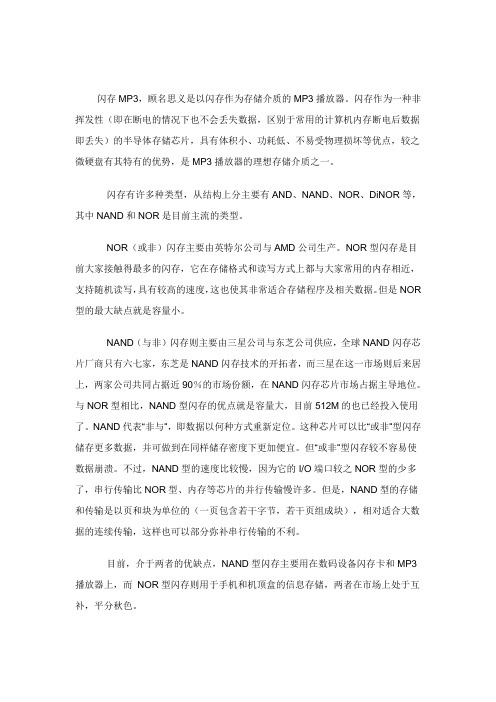
闪存MP3,顾名思义是以闪存作为存储介质的MP3播放器。
闪存作为一种非挥发性(即在断电的情况下也不会丢失数据,区别于常用的计算机内存断电后数据即丢失)的半导体存储芯片,具有体积小、功耗低、不易受物理损坏等优点,较之微硬盘有其特有的优势,是MP3播放器的理想存储介质之一。
闪存有许多种类型,从结构上分主要有AND、NAND、NOR、DiNOR等,其中NAND和NOR是目前主流的类型。
NOR(或非)闪存主要由英特尔公司与AMD公司生产。
NOR型闪存是目前大家接触得最多的闪存,它在存储格式和读写方式上都与大家常用的内存相近,支持随机读写,具有较高的速度,这也使其非常适合存储程序及相关数据。
但是NOR 型的最大缺点就是容量小。
NAND(与非)闪存则主要由三星公司与东芝公司供应,全球NAND闪存芯片厂商只有六七家,东芝是NAND闪存技术的开拓者,而三星在这一市场则后来居上,两家公司共同占据近90%的市场份额,在NAND闪存芯片市场占据主导地位。
与NOR型相比,NAND型闪存的优点就是容量大,目前512M的也已经投入使用了。
NAND代表“非与”,即数据以何种方式重新定位。
这种芯片可以比“或非”型闪存储存更多数据,并可做到在同样储存密度下更加便宜。
但“或非”型闪存较不容易使数据崩溃。
不过,NAND型的速度比较慢,因为它的I/O端口较之NOR型的少多了,串行传输比NOR型、内存等芯片的并行传输慢许多。
但是,NAND型的存储和传输是以页和块为单位的(一页包含若干字节,若干页组成块),相对适合大数据的连续传输,这样也可以部分弥补串行传输的不利。
目前,介于两者的优缺点,NAND型闪存主要用在数码设备闪存卡和MP3播放器上,而NOR型闪存则用于手机和机顶盒的信息存储,两者在市场上处于互补,平分秋色。
不过美国AMD与富士通的合资公司--著名闪存厂商美国Spansion日前发表了名为“ORNAND”架构的新技术。
该技术投入使用之后,闪存市场上平分秋色的NOR型和NAND型闪存间在性能和成本上的差别将不复存在。
镁光dram pin定义

镁光dram pin定义镁光DRAM是一种高速动态随机存储器,其性能优越,成本低廉,越来越受到人们的青睐。
在使用镁光DRAM时,了解pin的定义非常重要,因为pin的功能不同,会影响DRAM的工作效率和稳定性。
首先,我们来了解以下镁光DRAM的pin定义:1. Vss (地): 按照国际标准,Vss是指地线,用来接地。
2. Vcc (电源): Vcc是镁光DRAM的电源引脚,其电压通常为3.3伏。
3. WE# (写使能): WE#是镁光DRAM的写使能控制引脚,当它接地时,DRAM会处于写入状态。
4. RAS# (行地址选通): RAS#是镁光DRAM的行地址选通控制引脚,当它被置为低电平时,DRAM会接受行地址的信息。
5. CAS# (列地址选通): CAS#是镁光DRAM的列地址选通控制引脚,当它被置为低电平时,DRAM会接受列地址的信息。
6. OE# (输出使能): OE#是镁光DRAM的输出使能控制引脚,当它接地时,DRAM会处于输出状态。
7. CLK (时钟): CLK是镁光DRAM的时钟引脚,其频率通常为100MHz以上。
8. DQ0-DQ15 (数据线): 镁光DRAM的数据线共有16根,分别为DQ0-DQ15,可以传输读写数据。
以上是镁光DRAM的pin定义,我们可以看出,它们分别承担着不同的功能,如写入状态、行列选通、输出状态等。
在实际使用过程中,我们需要对这些pin进行正确的设置、控制和管理,以确保DRAM的稳定性和高效性。
在镁光DRAM的使用过程中,我们可以采用一些优化措施来提高其性能,如合理配置地址、优化数据传输、提高时钟频率等。
此外,我们还可以采用镁光DRAM调试工具来监测和调试DRAM的性能数据,以便及时发现和解决问题。
总之,了解镁光DRAM的pin定义及其作用,可以帮助我们更好地了解其工作原理和性能特点,并在使用过程中做好各方面的配置和管理,以获得更高的系统性能和稳定性。
NandFlash引脚(Pin)的说明

NandFlash引脚(Pin)的说明Nand Flash引脚(Pin)的说明图3.Nand Flash引脚功能说明上图是常见的Nand Flash所拥有的引脚(Pin)所对应的功能,简单翻译如下:1. I/O0 ~ I/O7:用于输入地址/数据/命令,输出数据2. CLE:Command Latch Enable,命令锁存使能,在输入命令之前,要先在模式寄存器中,设置CLE使能3. ALE:Address Latch Enable,地址锁存使能,在输入地址之前,要先在模式寄存器中,设置ALE使能4. CE#:Chip Enable,芯片使能,在操作Nand Flash之前,要先选中此芯片,才能操作5. RE#:Read Enable,读使能,在读取数据之前,要先使CE#有效。
6. WE#:Write Enable,写使能,在写取数据之前,要先使WE#有效。
7. WP#:Write Protect,写保护8. R/B#:Ready/Busy Output,就绪/忙,主要用于在发送完编程/擦除命令后,检测这些操作是否完成,忙,表示编程/擦除操作仍在进行中,就绪表示操作完成.9. Vcc:Power,电源10. Vss:Ground,接地11. N.C:Non-Connection,未定义,未连接。
[小常识]在数据手册中,你常会看到,对于一个引脚定义,有些字母上面带一横杠的,那是说明此引脚/信号是低电平有效,比如你上面看到的RE头上有个横线,就是说明,此RE是低电平有效,此外,为了书写方便,在字母后面加“#”,也是表示低电平有效,比如我上面写的CE#;如果字母头上啥都没有,就是默认的高电平有效,比如上面的CLE,就是高电平有效。
【为何需要ALE和CLE】突然想明白了,Nand Flash中,为何设计这么多的命令,把整个系统搞这么复杂的原因了:比如命令锁存使能(Command Latch Enable,CLE)和地址锁存使能(Address Latch Enable,ALE),那是因为,Nand Flash就8个I/O,而且是复用的,也就是,可以传数据,也可以传地址,也可以传命令,为了区分你当前传入的到底是啥,所以,先要用发一个CLE(或ALE)命令,告诉nand Flash的控制器一声,我下面要传的是命令(或地址),这样,里面才能根据传入的内容,进行对应的动作。
认识闪存的分类及参数介绍

认识闪存的分类及参数介绍我们常说的闪存其实只是一个笼统的称呼,准确地说它是非易失随机访问存储器(NVRAM)的俗称,特点是断电后数据不消失,因此可以作为外部存储器使用。
而所谓的内存是挥发性存储器,分为DRAM和SRAM两大类,其中常说的内存主要指DRAM,也就是我们熟悉的DDR、DDR2、SDR、EDO等等。
闪存也有不同类型,其中主要分为NOR型和NAND型两大类。
闪存的分类NOR型与NAND型闪存的区别很大,打个比方说,NOR型闪存更像内存,有独立的地址线和数据线,但价格比较贵,容量比较小;而NAND型更像硬盘,地址线和数据线是共用的I/O线,类似硬盘的所有信息都通过一条硬盘线传送一般,而且NAND型与NOR型闪存相比,成本要低一些,而容量大得多。
因此,NOR型闪存比较适合频繁随机读写的场合,通常用于存储程序代码并直接在闪存内运行,手机就是使用NOR型闪存的大户,所以手机的“内存”容量通常不大;NAND型闪存主要用来存储资料,我们常用的闪存产品,如闪存盘、数码存储卡都是用NAND型闪存。
这里我们还需要端正一个概念,那就是闪存的速度其实很有限,它本身操作速度、频率就比内存低得多,而且NAND型闪存类似硬盘的操作方式效率也比内存的直接访问方式慢得多。
因此,不要以为闪存盘的性能瓶颈是在接口,甚至想当然地认为闪存盘采用USB2.0接口之后会获得巨大的性能提升。
前面提到NAND型闪存的操作方式效率低,这和它的架构设计和接口设计有关,它操作起来确实挺像硬盘(其实NAND型闪存在设计之初确实考虑了与硬盘的兼容性),它的性能特点也很像硬盘:小数据块操作速度很慢,而大数据块速度就很快,这种差异远比其他存储介质大的多。
这种性能特点非常值得我们留意。
NAND型闪存的技术特点内存和NOR型闪存的基本存储单元是bit,用户可以随机访问任何一个bit的信息。
而NAND型闪存的基本存储单元是页(Page)(可以看到,NAND型闪存的页就类似硬盘的扇区,硬盘的一个扇区也为512字节)。
- 1、下载文档前请自行甄别文档内容的完整性,平台不提供额外的编辑、内容补充、找答案等附加服务。
- 2、"仅部分预览"的文档,不可在线预览部分如存在完整性等问题,可反馈申请退款(可完整预览的文档不适用该条件!)。
- 3、如文档侵犯您的权益,请联系客服反馈,我们会尽快为您处理(人工客服工作时间:9:00-18:30)。
Secure Digital I/O Card DescriptionSecure Digital Input/Output [SDIO] is a flash based removable memory card. The card format may also be used for other device functions in addition to data storage. Secure Digital IO uses a 9-Pin connector [1 row of 9 pins]. SDIO is based on the Secure Digital SD card. SDIO is compatible with the SD memory card, and fits in the same socket.The Secure Digital I/O card dimensions are: 24mm wide x 32mm long x 2.1mm thick.There are two types of SDIO cards; a full-speed version, and a slow-speed version. The full-speed version will operate with a 1-bit and 4-bit SD transfer mode, both with a clock ranging from 0Hz to 25MHz. The 4-bit version operating at 25MHz has a transfer rate of 100Mbps. The slow-speed version will use the 1-bit mode and may have the 4-bit mode, but only operates at a transfer rate of between 0Hz and 400kHz. The slow-speed version is not intended for memory functions. The SDIO card support the SPI bus interface. The SDIO mechanical form factor is shown above; however a few gaps "lock notches" are not shown. The SDIO card may exceed 24mm in width after 37mm in length, and the width may be thicker then 2.1mm after 37mm in lengthT he Secure Digital memory card is a memory specifically developed to meet security requirements which have appeared in the field of electronic audio and video devices. It includes a Copyright protection mechanism which complies with the SDMI standard (Secure Digital Music Initiative). The file protection and encryption system (CPRM: Content Protection for Recordable Media) is integrated into the SD card. The SD card's interface supports standard MMC card operations.Secure Digital I/O Card, Pin OutMemory Stick description and Pin OutMemory Stick is another type of Removable NAND-type small flash memory card format which was introduced in 1998. There are a few different Memory Stick formats: the Standard-size Memory Stick media measures 50.0mm x 21.5mm x 2.8mm [Width x Height x Depth], and the Memory Stick Duo media measures 31.0mm x 20.0mm x 1.6mm [Width x Height x Depth]. Pins 1 and 10 are longer then the other pins so ground is the first pin to make contact and the last to break contact. Pin 6 is recessed and make contact last as the stick is inserted. The pins are flat electrodes. The maximum transfer rate is 2.54MBps, with a maximum clock frequency of 40MHz. Memory Stick requires a power supply voltage of 2.7v to 3.6 volts.Memory Stick - Memory Stick Pro - 10 pin connectorNote: both Pin 1 and Pin 10 shall be connected to VSS.Memory Stick, Memory Stick Duo, MagicGate, MagicGate Memory Stick, MemoryStick PRO are registered trademarks or trademarks of Sony Corporation.Multi Media Card, Pin OutMultiMedia Card uses a 7-Pin connector [1 rows of 7 pins]. The 7-pin connector is on 2.5-mil centers. The seven pin interface consists of three pins dedicated to the SPI serial bus [SCK, SI, and SO], a Chip Select signal [CS], a Chip Reset [RESET], a Write Protect line [WP], and an output Ready/Busy [RDY/Busy] signal. All of the control signals execpt the RDY signal are active low. The SPI interface uses the Serial Clock [SCK] line, Serial Input [SI], and the Serial Output [SO] line. How ever the physical DataFlash card does not have all the signals listed above, refer to the pinout table shown below. A few of the signals listed above may only be found on the DataFlash Integrated Circuits [ICs]. A smaller form factor of MMC is called Reduced Size MultiMedia Card [RS-MMC]. The RS-MMC card is 24mm x 16mm x 1.5mm. The RSMMC remains pin compatible with the MMC module, but shorterThe newer versions of the standard; MMCplus, MMCmobile and MMCmicro, offer the higher transfer speeds up to 52MB/sec, or 416 Mbits/sec, and support for dual-voltage operation (1.8 and 3/3.3V), and multiple bus widths (x1, x4 and x8 bit). MMCplus, MMCmobile and MMCmicro utlize 13 pins while remaining backwards compatible with the previous version of 7-pin MMC cardsMultiMedia Card - 7 pin connectorSmartMedia Description and Pin OutSmartMedia is another type of Removable NAND-type small flash memory card format. The SmartMedia device size is 45 mm x 37 mm x 0.76 mm [thick]. SmartMedia cards operate using either 3.3 volt or 5 volt. Solid State Floppy Disk Card [SSFDC] is the old name for SmartMedia, which was changed in 1996. SSFDC was Developed by Toshiba Corp. Current SmartMedia storage format include 16-Mbit, 32-Mbit, and 64-Mbit NAND-type flash memory chips. The SmartMedia card does not use a connector, instead it uses a contact area as shown in the graphic below. The graphic also defines the pinout.Pin assignment of 5V and 3.3V SmartMedia TM。
